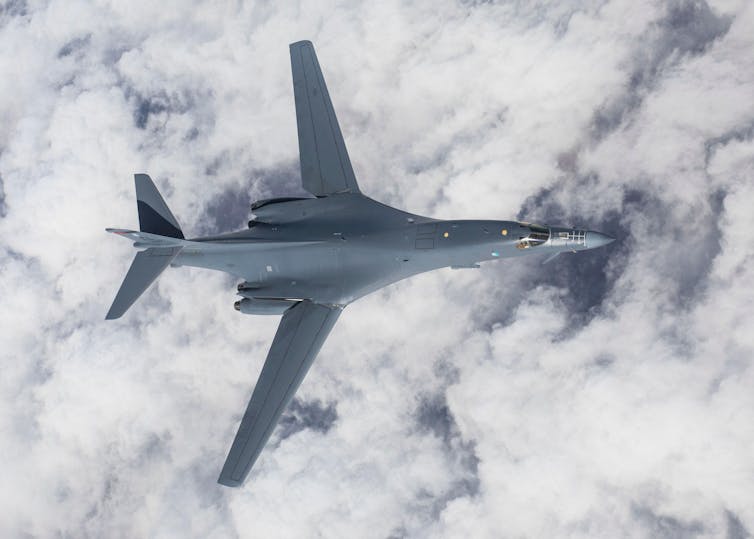The British military is currently “too slow and resistant to change”, according to Admiral Sir Tony Radakin, the UK’s chief of defence staff. The urgent always takes priority over the important. But in the context of one of the world’s biggest security issues – climate change – threats and adaptations are evolving at pace.
In summer 2021, the UN’s Intergovernmental Panel on Climate Change raised the threat level posed by climate change to a “code red for humanity”. Anthropogenic climate change is at once evident and escalating, transforming natural, economic and socio-political environments. As well as mitigating threats, governments and their militaries are manoeuvring to exploit opportunities and leverage advantage.
A range of climate scenarios have been forecast – but common to all is increased frequency and scale of extreme weather events, more droughts and floods, melting of ice caps and permafrost, rise in sea levels, and oceanic acidification and deoxygenation.
Both human and national security will almost certainly be affected by threats to agricultural regimes including increased pest and disease presence, spikes in food prices and shocks to food production and food logistics. Consequences will include the recalibration of diplomatic alliances, displacement and dispossession of peoples, border disputes, endemic famine and warfare.
The tempo of the threat from the climate has accelerated. Certain parts of the world are becoming “climate conflict hotspots”. The effects of climate change shape, proliferate and amplify the threat, interacting in complex ways with pre-existing vulnerabilities such as socioeconomic inequality, fragile governance and inter-group tensions.
The UN reports that temperature increases in the Sahel region of Africa will be 1.5 times higher than the global average. This is an existential problem for many countries in the region, such as Mali, where destructive weather already jeopardises agricultural production. With an population growth rate of nearly 3%, Mali is also one of the youngest and fastest-growing populations in the world.

Tensions between ethnic groups, for example the Fulani and Dogon, have been aggravated by decades of cattle-herding and horticulture relocation as well as migration into urban centres. Violent clashes over grassland, water sources and local infrastructure have become common.
Scorched earth is only fertile as a recruitment ground for violent and extremist organisations. Terrorist groups such as Boko Haram, Islamic State West Africa (ISWA), Jamaat Nusratul Islam wal-Muslimin (JNIM) and Katiba Macina pose a threat in the Sahel, often with the intent and capabilities to mount complex attacks against government and civilian targets.
Arctic militarisation
In the Arctic, melting sea ice is amplifying strategic competition as the accessibility of resources improves, particularly mineral and fossil fuel deposits. New trade routes are emerging, the Northern Sea Route (NSR), for example, is projected to rival Suez Canal traffic and shift trade flows between Asia and Europe. Russia has declared the NSR “a national transportation corridor” as a means to ensure exclusive access to it.
Others, such as China and the US, however, have indicated that they regard it as an “international domain”. In reference to the “Polar Silk Road”, China has started to refer to itself as a “near Arctic state”, something that, in absolute terms, is geographically false. Assorted Arctic and non-Arctic countries are building ice-breakers to capitalise on these new economic realities.
In turn, the high north is facing an unprecedented process of militarisation. Russia is investing heavily in defence infrastructure and performing its power through the presence of nuclear submarines, MiG-31 Foxhound aircraft flights over the north pole and into US and Scandinavian airspace, and exercises of their Arctic Motorised Brigade. In concert, this posturing informs Russia’s various competitors that it is present and, if required, will use force to defend its strategic interests.

Nato has been similarly present in the contest. US president Joe Biden, for example, has relaunched Arctic Warrior, a cold war training programme – and, in early 2021, dispatched B-1 Lancer strategic bombers to Norway. This brought Russian military targets in the Arctic and beyond within reach. In response and to signal a posture of competition, Russia sent a missile cruiser from its Northern Fleet to the area.
Carbon bootprints
Climate change also amplifies national security risks. There are physical risks. Many coastal naval bases are, for example, at risk from sea level rises. There are liability risks. Countries, particularly those in the global south, are going to seek damages from others for loss and damage resulting in economic, physical and cultural harms.
On a global scale, the greenhouse gas emissions of militaries contribute immensely to the climate crisis. And, as the UK secretary of state for defence, Ben Wallace made clear at COP26, the need to reduce military emissions must be part of the route to sustainability. His comments were in line with the ambitions presented in the Ministry of Defence’s Climate Change and Sustainability Strategic Approach.
Action has followed words. In the UK, the army has invested in prototype electric hybrid armoured, reconnaissance and logistic vehicles, with significantly reduced emissions and improved performance. The electric trucks that transport a field hospital can now supply power for up to 12 hours, providing the equivalent of nine diesel generators. New buildings on the military’s training estate are also net negative, supplied from renewable sources such as anaerobic digesters and solar farms.
The Royal Air Force recently achieved a world first flight powered by 100% synthetic fuel, authorised the use of 50% sustainable aviation fuel in all its aircraft, and plans to order electric-powered planes for training. The Royal Navy, meanwhile, is incorporating alternative-fuelled sustainability into new ship design.
In addressing their carbon bootprint, militaries enhance their role in sustainable security. Moreover, as agents of “climate diplomacy”, they can influence positive change in other nations and government departments. This is becoming a vital role in a warming and increasingly insecure world.
This article was co-authored by Lieutenant General (Retired) Richard Nugee, a Senior Research Associate of the Climate Change & (In)Security Project, a collaboration between Oxford University and the Centre for Historical and Conflict Research (CHACR).

